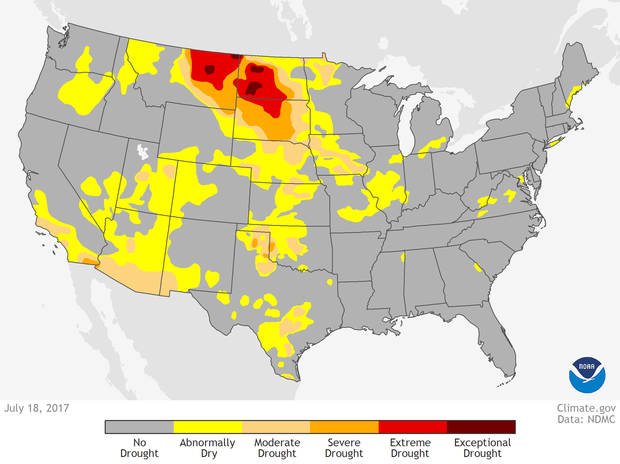ScienceRocks
Democrat all the way!
- Mar 16, 2010
- 59,455
- 6,797
Flash Drought In US High Plains May Have Already Destroyed Half Of This Year’s Wheat Crop
August 5th, 2017 by James Ayre
Quote
The “flash drought” that came out of nowhere this summer in the US High Plains, afflicting Montana and the Dakotas the worst, has already destroyed more than half of this year’s wheat crop, going by some recent field surveys. Considering that the region is now one of the top wheat-growing regions in the world, the damage is very notable.
North Dakota drought. Image by U.S. Drought Monitor
What’s particularly “interesting” about the situation is how quickly the drought developed. It arose over just the last ~3 months — hence the phrase “flash drought” — and it quickly worsened. The US Drought Monitor recently upgraded the drought to “exceptional” — matching the intensity of the relatively recent drought in California, but developing over a shorter period of time.
[/QUOTE]
Flash Drought In US High Plains May Have Already Destroyed Half Of This Year’s Wheat Crop
wow, this sucks.
August 5th, 2017 by James Ayre
Quote
The “flash drought” that came out of nowhere this summer in the US High Plains, afflicting Montana and the Dakotas the worst, has already destroyed more than half of this year’s wheat crop, going by some recent field surveys. Considering that the region is now one of the top wheat-growing regions in the world, the damage is very notable.
North Dakota drought. Image by U.S. Drought Monitor
What’s particularly “interesting” about the situation is how quickly the drought developed. It arose over just the last ~3 months — hence the phrase “flash drought” — and it quickly worsened. The US Drought Monitor recently upgraded the drought to “exceptional” — matching the intensity of the relatively recent drought in California, but developing over a shorter period of time.
[/QUOTE]
Flash Drought In US High Plains May Have Already Destroyed Half Of This Year’s Wheat Crop
wow, this sucks.




